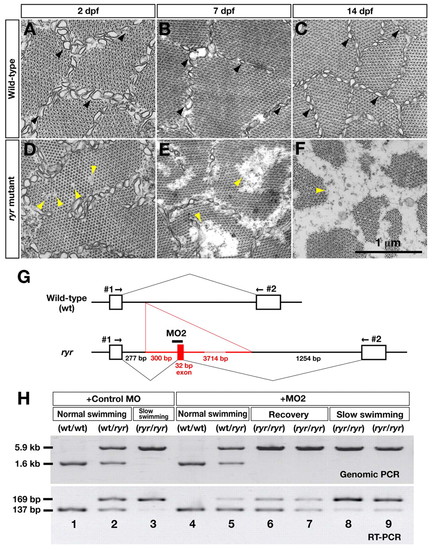
ryr mutants exhibit a minicore phenotype similar to that observed in MmD and the behavioral phenotype can be rescued by preventing aberrant splicing of ryr1b mRNA. (A-C) Electron micrographs of wild-type fast muscles showing sarcoplasmic reticulum (SR; black arrowheads), and bundles of actin and myosin at 2, 7 and 14 dpf. (D-F) Amorphous cores are seen in ryr mutants (yellow arrowheads). Diameters of the cores are 50-100 nm, 50-500 nm and 100-800 nm at 2, 7 and 14 dpf, respectively. The SR is disorganized at 7 dpf and missing at 14 dpf. (G) The behavioral defects of ryr mutants are treatable by an antisense morpholino that blocks abnormal splicing of ryr1b mRNA. A diagram showing the wild-type and mutant ryr1b genes with the location of the morpholino (MO2) that was designed against the splice acceptor site of the aberrant exon of the mutant gene is shown. (H) Control MO (lanes 1-3) or MO2 (lanes 4-9) was injected into the progeny of an ryr carrier incross. Swimming of injected embryos was examined at 36 hpf, and the head and trunk of individual embryos were subjected to genomic PCR and RT-PCR, respectively. Control MO-injected wt/wt embryos exhibited normal swimming and expressed only the wild-type, short fragment by RT-PCR (lane 1). Control MO-injected wt/ryr embryos exhibited normal swimming and expressed both the wild-type short and the mutant long fragments (lane 2). Control MO-injected ryr/ryr embryos exhibited slow swimming and predominantly expressed the mutant fragment (lane 3). MO2-injected wt/wt embryos exhibited normal swimming and expressed only the wild-type, short fragment (lane 4). MO2-injected wt/ryr embryos exhibited normal swimming and expressed both fragments (lane 5). In mutant embryos (ryr/ryr) showing recovery of swimming, normal splicing (short band) was increased (lanes 6, 7 compared to lane 3). On the other hand, in mutants that exhibited slow swimming, the proportion of wild-type mRNA was much lower (lanes 8, 9) compared to mutants that exhibited recovery (lanes 6, 7).
|

